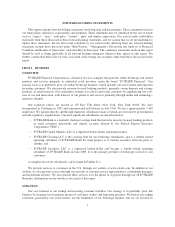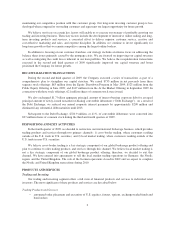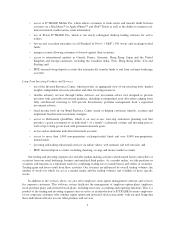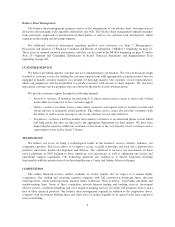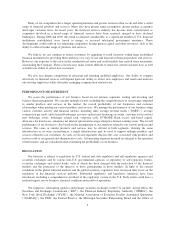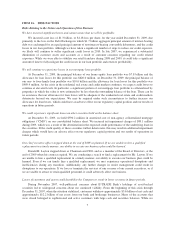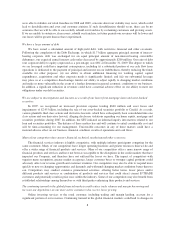eTrade 2009 Annual Report Download - page 14
Download and view the complete annual report
Please find page 14 of the 2009 eTrade annual report below. You can navigate through the pages in the report by either clicking on the pages listed below, or by using the keyword search tool below to find specific information within the annual report.communications with investors regarding investment preferences and risk tolerances. Publicly available
documents may be inaccurate and misleading, resulting in recommendations or transactions that are inconsistent
with the investors’ intended results. In addition, advisors may not understand investor needs or risk tolerances,
failures that may result in the recommendation or purchase of a portfolio of assets that may not be suitable for the
investor. To the extent that we fail to know our customers or improperly advise them, we could be found liable
for losses suffered by such customers, which could harm our reputation and business.
Our international operations subject us to additional risks and regulation, which could impair our business
growth.
We conduct business in a number of international locations, sometimes through joint venture and/or licensee
relationships. Action or inaction in any of these operations, including the failure to follow proper practices with
respect to regulatory compliance and/or corporate governance, could harm our operations and/or our reputation.
We have a significant deferred tax asset and cannot assure it will be fully realized.
We had net deferred tax assets of $1.4 billion as of December 31, 2009. We did not establish a valuation
allowance against our federal net deferred tax assets as of December 31, 2009 as we believe that it is more likely
than not that all of these assets will be realized. In evaluating the need for a valuation allowance, we estimated
future taxable income based on management approved forecasts. This process required significant judgment by
management about matters that are by nature uncertain. If future events differ significantly from our current
forecasts, a valuation allowance may need to be established, which would have a material adverse effect on our
results of operations and our financial condition.
As a result of the Public Equity Offering, the Debt Exchange and related transactions, we believe that we have
recently experienced an “ownership change” for tax purposes that could cause us to permanently lose a
significant portion of our U.S. federal and state deferred tax assets.
As a result of the Public Equity Offering, the Debt Exchange and related transactions, we believe that we
have recently experienced an “ownership change” as defined under Section 382 of the Internal Revenue Code of
1986, as amended (which is generally a greater than 50 percentage point increase by certain “5% shareholders”
over a rolling three year period). Section 382 imposes an annual limitation on the utilization of deferred tax
assets, such as net operating loss carryforwards and other tax attributes, once an ownership change has
occurred. Depending on the size of the annual limitation (which is in part a function of our market capitalization
at the time of the ownership change) and the remaining carryforward period of the tax assets (U.S. federal net
operating losses generally may be carried forward for a period of 20 years), we could realize a permanent loss of
a portion of our U.S. federal and state deferred tax assets and certain built-in losses that have not been recognized
for tax purposes. We believe the tax ownership change will extend the period of time it will take to fully utilize
our pre-ownership change net operating losses (“NOLs”), but will not limit the total amount of pre-ownership
change NOLs we can utilize. This is a complex analysis and requires the Company to make certain judgments in
determining the annual limitation. As a result, it is possible that we could ultimately lose a significant portion of
our deferred tax assets, which could have a material adverse effect on our results of operations and financial
condition.
Risks Relating to the Regulation of Our Business
We are subject to extensive government regulation, including banking and securities rules and regulations,
which could restrict our business practices.
The securities and banking industries are subject to extensive regulation. All of our broker-dealer
subsidiaries have to comply with many laws and rules, including rules relating to sales practices and the
suitability of recommendations to customers, possession and control of customer funds and securities, margin
lending, execution and settlement of transactions and anti money-laundering. We are also subject to additional
laws and rules as a result of our market maker operations.
11


